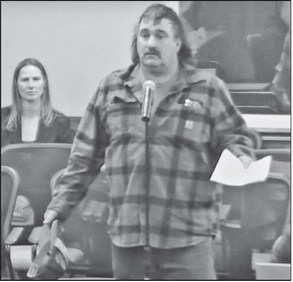Working group starts discussing phosphorus issue


By Kevin O ’Brien
A 25-member group that includes farmers, township officials and the DNR has started to discuss a possible compromise on reducing phosphorus runoff in Marathon County, with an initial report of the group’s ideas expected at next month’s Environmental Resources Committee (ERC) meeting.
The informal working group was formed in response to complaints from small-scale dairy farmers about a county proposal to ban manure spreading during the months of February and March and to heavily restrict the practice at other times when the ground is frozen.
County conservationist Kirstie Heidenreich told the ERC at its April 1 meeting that the working group planned to have its first meeting the following day in the town of Rietbrock. She noted that farmers from a wide range of operations, from CAFOs to small farms, would be participating in the discussion, along with representatives from the DNR and the Wisconsin Valley Improvement Company, which operates the Big Eau Pleine Reservoir.
“We have a really good group of people and we’re hoping to have a really well-rounded, productive discussion,” she said.
Cleaning up the Big Eau Pleine River, and the reservoir it drains into, has long been a goal of the county’s Conservation, Planning and Zoning Department and other groups interested in keeping the waterway clear of toxic algae blooms fed by phosphorus. Manure and other agricultural fertilizers are a well-known source of phosphorus, so CPZ has concentrated its efforts on reducing the amount of runoff from fanns in lo-cal creeks and streams.
Earlier this year, after months of discussion, CPZ staff unveiled a proposal to limit winter manure spreading, which would have had the biggest impact on mid and small-sized dairy farms who rely on land spreading throughout the year because they do not have adequate storage facilities. One possible solution to this problem is to match these farmers with landowners who have unused manure pits, but that idea has met with logistical concerns.
Following initial feedback from farmers, county officials agreed to fonn a working group of fanners and others to hash out their different ideas before coming back with a new proposal for the ERC and county board to consider.
ERC chairman Jacob Langenhahn said having 25 members in the group made him “a little apprehensive” at first.
“On the other hand, it shows that people are engaged,” he said. “I hope that the conversations are thoughtful and efficient.”
Heidenreich said the 25 members were chosen with the knowledge that many of them are farmers and may not be available to attend eveiy group meeting. She promised a “robust update” of the group’s discussion at the ERC’s next meeting in May.
During the public comment portion of the April 1 meeting, two daily farmers from the town of Day, Kevin Schmidtke and Trine Spindler, spoke to the committee about their concerns as small-scale operators who would be directly impacted by any type of spreading restrictions.
Schmidtke said he wanted to see for himself how much phosphorus was in the waterways around his farm, so he went to AgSource in Marshfield and got five testing bottles to sample water from five different locations. The results showed phosphorus levels ranging from .05 mg/L near the CTH 0 bridge to . 110 mg/L at the Big Eau Pleine Park boat landing, he said.
The testing cost him $100 and took about four hours of his time, he said, urging committee members to get similar reports on a regular basis if they want to know much farm runoff is affecting the environment. Schmidtke said there are “very few small fanns left,” and questioned how much phosphorus was coming from other sources, such as road salt, paper mills, the airport and the county landfill.
“If we’re going to research something, can we trust but verify?” he said.
Spindler urged the committee to read the book “Land Rich, Cash Poor” by Brian Riesinger to learn about the challenges facing small farmers and also mentioned a recent conference held at Marquette University. A recording of the conference, “Resolving the Tension Between Agriculture and Water Quality in the Dairy State,” is available on YouTube and features a panel discussion by representatives of the DNR, Wisconsin Farm Bureau and Clean Wisconsin.
Those involved in this topic are finding that nutrient management plans are the best way to address phosphorus ranoff and not necessarily ordinances that restrict winter spreading, Spindler said. She urged ERC members to encourage voluntary changes by fanners rather than passing restrictions.
“This stuff stays in the soil for a long time,” she said. “I’m not saying we’re not supposed to do anything. I’m just saying that you have to be patient to see results.”
Wind/solar ordinance OK’d
The committee voted unanimously to approve a newly revised ordinance adopted by the town of Ringle regarding wind and solar energy operations.
When an earlier draft of the ordinance was brought before the ERC in Febmary, land resources manager Shad Harvey said CPZ staff found several provisions that were more restrictive than what the state allows under PSC 128, a set of regulations that apply to all projects of 100 kilowatts or more.
Harvey said the original ordinance gave the township pennitting authority that it does not have under state law, according to an analysis by CPZ and the county attorney’s office. After Febraary’s meeting, Haivey said the ordinance was changed so that its permitting requirements were replaced with recommendations.
ERC member Marilyn Bhend questioned how Ringle’s ordinance was any different from a wind ordinance from the town of Rietbrock that was rejected by the committee last year. Harvey said Rietbrock’s ordinance overstepped the town’s authority, and Ringle’s does not.
“This is a zoning code that they’re doing, not a licensing ordinance,” she said. “This one right now falls in line with the state’s requirements.”
- Farmer Kevin Schmidtke from the town of Day presents information on phosphorus levels to the Marathon County Environmental Resources Committee last week. Also pictured is fellow farmer Trine Spindler.
SUBMITTED PHOTO
